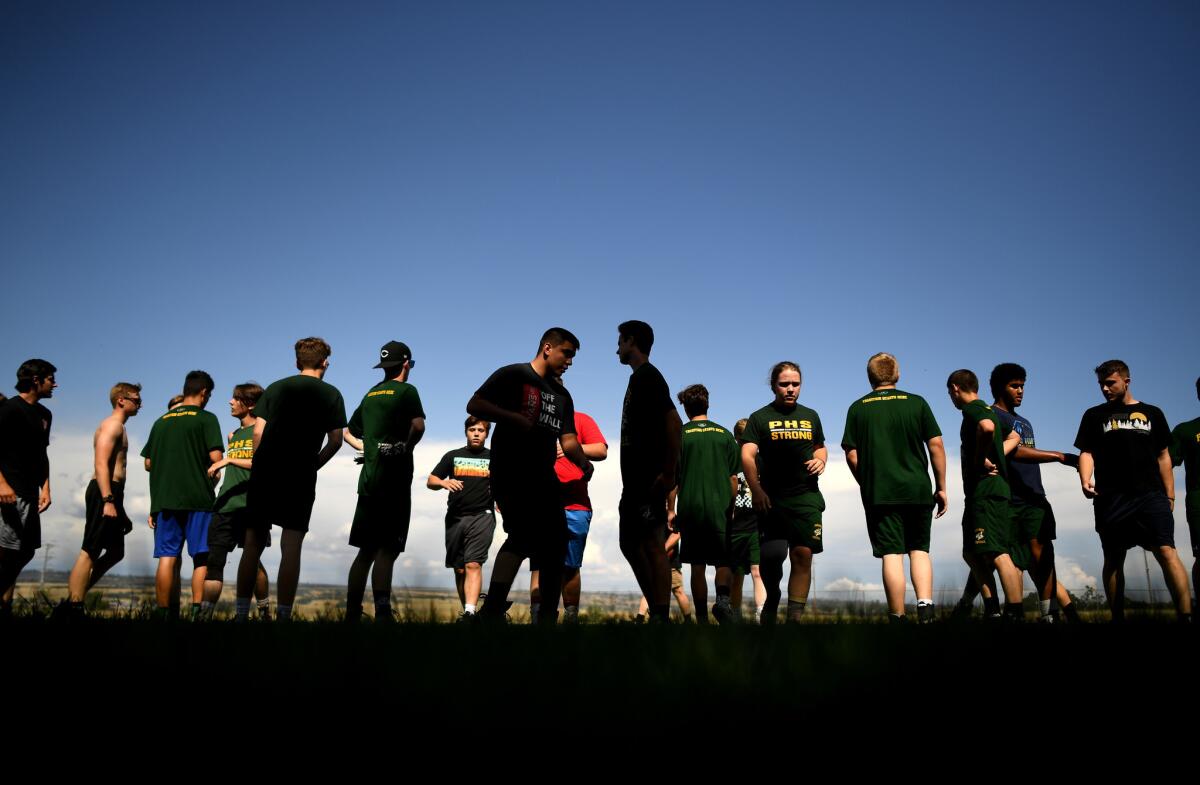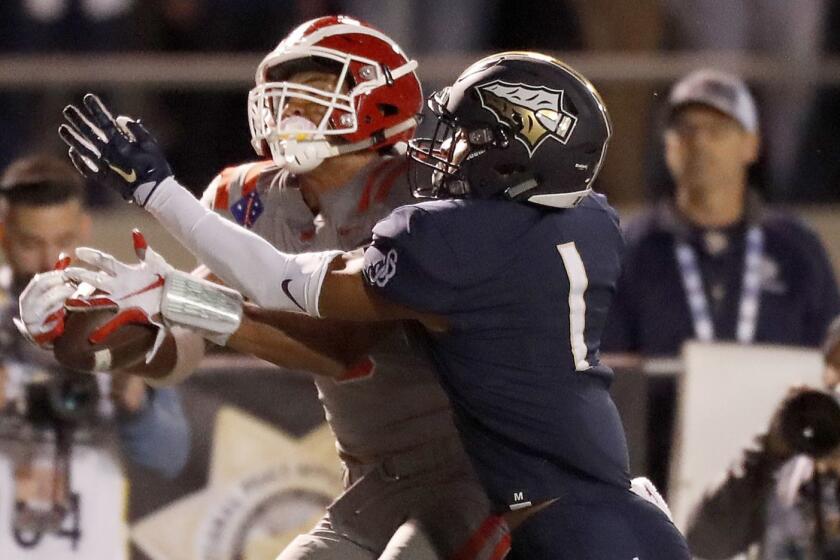Fewer California high school students are playing football

- Share via
An annual survey of high schools in California shows a marked decrease in football participation for a fourth consecutive year.
The latest numbers, released by the California Interscholastic Federation (CIF) on Thursday, showed that 91,305 of the state’s high school students played football last fall, a drop of 3.1%.
Statewide participation in football has dwindled steadily — by more than 12,000 — since 2014-15, when there was a high of 103,725 students involved. The numbers are down nationally, too, having dropped in schools with 11-man football teams by 27,865 in 2016 and 21,465 in 2017. Nationwide participation from last season will be announced later this month by the National Federation of State High School Associations.
Locally, the decline can be seen at every level of the high school game. As Lake Balboa Birmingham High began practice earlier this week, the junior varsity team that had about 60 freshmen try out last season was down to 45.
One often-cited reason for the smaller numbers is the risk of catastrophic injuries, as more attention is paid to significant brain trauma caused by repetitive blows to head.
Improvements in tackling technique, equipment and concussion protocols have been implemented, but it remains to be seen if that will be enough to regain the trust of parents debating whether the risk of injury in football is too great.
A list of the high school football zero week schedule.
“Parents are afraid of head injuries. That’s the problem,” said Alonzo Regaldo, a sophomore in Birmingham’s football program.
But the specter of injuries isn’t the only factor.
One Birmingham freshman said his cousin decided not to play football because he’s spending his time playing Rainbow Six, a hot new video game. Just this week, a 16-year-old won $3 million in a video-game competition called the Fortnite World Cup.

Daniel Hill, another freshman at Birmingham, said football was simply too much time and effort for some students. “There are a lot who don’t want to put in the work to accomplish something,” he said. “They want immediate satisfaction.”
Terry Barnum, director of athletics at Studio City Harvard-Westlake High, said teams were losing athletes who used to come out for football as a second sport but were increasingly choosing to focus year-around on a specialty.
“The kids who football isn’t their primary sport aren’t playing anymore,” said Barnum, a former USC tailback.
Ryan Stromsborg said the oldest of his two sons, who attend Sherman Oaks Notre Dame High, played football until he began his freshman year. Now he focuses exclusively on baseball.
“Kids are naturally migrating into other sports, and the single-sport athlete has impacted football,” Stromsborg said. “When you’re always coming back to your season late and the rest have been practicing, you have catching up to do no matter how good you are. … Families are finding a different sport to play.”
Bryce Young, DJ Uiagalelei, Ethan Garbers lead talented group of quarterbacks
This year, lacrosse becomes an additional option. It is an official championship sport for the first time in the CIF Southern Section, which encompasses 565 local schools. There were already 119 boys’ lacrosse teams statewide this past spring.
Overall, there were 814,004 sports participants at the CIF’s 1,606 schools during the last school year. Football, despite its decline, was still far and away the most popular sport — track and field was second, with 55,335 participants — but soccer enjoyed the biggest growth, increasing 3.87% to 54,996.
Gary Bernardi, who has coached football at eight different colleges in a career spanning more than four decades, lamented the loss in community spirit that has accompanied the fall in football participation at all levels.
“When I was 8 years old, I went to see Van Nuys and Monroe [high school] games on Friday nights,” Bernardi said. “You go to games now, how many little Pop Warner kids are attending? I was with the Valley Chargers and there might be 25 kids from different levels at games. You looked forward to it and looked up to the guys and looked forward to playing.”
Bernardi, currently an analyst for the offensive line at San Diego State, said he was also concerned that young people and their families were losing out on an opportunity to receive instruction from coaches who could become lifetime mentors.
He said he recently visited his former high school coach from Monroe, Harry Frum, who is 85.
Bernardi was 12 when he first met Frum in 1967.
“In every major decision in my life,” Bernardi said, “I’ve talked to Harry Frum.”
More to Read
Get our high school sports newsletter
Prep Rally is devoted to the SoCal high school sports experience, bringing you scores, stories and a behind-the-scenes look at what makes prep sports so popular.
You may occasionally receive promotional content from the Los Angeles Times.









